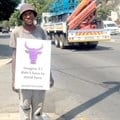How I wrote a shopper marketing strategy for a new political party
Think about it. You’re in the coffee aisle. You’re looking for your brand, the one you buy no matter what. Or maybe you’re shopping on price. Possibly you’re open to something new. No matter what kind of shopper you are, the one thing that will guide you on making your decision is the most basic of all: the packaging.
That’s the approach I took when Kanthan Pillay told me last June that he was planning to start a new political party. Without a distinctive logo that would stand out in an incredibly crowded space where everything is tiny, everything we spent on marketing and advertising up to that point would be a waste.
Working backwards from the moment of truth
So I worked backwards. What would stand out on the ballot sheet? What would the emotional state of the voter be? And how would that shape our strategy?
I identified 3 things we’d need at that ultimate moment of truth, the one shot we would have at our prospect for five long years.
Firstly, to be distictive. Secondly, to be understood enough that our distinctiveness stood for something. Thirdly, to be liked enough to prompt action, making the cross next to us rather than someone else.
Given the name of the party, the initial logos that Kanthan had in mind were all related to money in some way – a coin, or the animals from bank notes. It was then that the obvious answer struck me: how about… a cow?
I’d been painting Nguni cattle for years, and this was the traditional symbol of wealth in sub-Saharan Africa. A bull market is a good thing in international markets, so this was a neat way of combining traditional culture and global realities. And because of the Seth Godin marketing classic, and the fact that at the time, there were no other parties using purple, the cow had to be purple.

I painted a scamp of the cow using markers and craft acrylic, and the rest is history. This is the painting that will be printed onto millions of ballot papers ahead of the election on 8 May.
That was then. Now that we know that a record 48 parties are on the ballot, our strategy was even more on the mark. (Not long after we formulated the communication strategy, an expert with many years’ experience polling political campaigns told us we’d need R20 million to make an impact. So far, we’ve spent 2% of that.)
The hero is always the cow
Everything in the strategy has flowed from the need to make our logo on the ballot sheet both famous and meaningful. So the hero of the campaign is the cow rather than the people associated with the party, and everything we’ve done is with the aim of demonstrating that we don’t just say we’re different – we are different.
The purple cow first appeared in November 2018 with a series of weekly videos highlighting solutions to various issues, but without telling the public that this was a planned political party (if anyone had been reading the Government Gazette, they would have spotted it right away – but nobody pays attention.)
Once we were closer to officially registering to compete on the national ballot, we launched the first phase of our above-the-line campaign, one that literally created jobs for 35 people. (I’m in the process of registering a company with 3 of the people I work with as directors, with the ambition of creating a sustainable source of income for them.)
We kept the CI very simple and allowed supporters to play with our brand – while being clear about its core values. The spontaneous avatars and memes that started appearing the moment the cow was out of the bag suggested that we have created something that is genuinely meaningful for party supporters.
Only the results from 8 May will tell us whether the strategy was a good bet or an exceedingly risky one – and perhaps both, because the biggest risk you can take when launching a completely new brand in a very cluttered category dominated by massive incumbents is to never take a risk at all.
#VotePurpleCow is probably the most unconventional party political campaign ever to run in South Africa. If nothing else, we’ve shown that it’s possible to innovate in a category that needs fresh ideas and new thinking, and that it’s something that gets voters excited.































